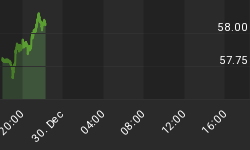Paraphrasing Stanley Kubrick's great cold war/nuclear paranoia film Dr. Strangelove (1964).

The USA thrived during a 20th century rife with war, famine and depression. This was a wealthy country however, founded on principles of self-reliance and valuing thrift, saving and honest work for an honest return. Add in unparalleled productivity and economically at least, the positives more than outpaced the negatives.
Until the 1980s the United States had a Federal Reserve that one might argue considered itself a steward of a more honest (though totally paper-based) monetary system.

Courtesy SlopeCharts
The huge spike in interest rates in 1980 was due to the Volcker Fed's apparent intention to pop the bubble in inflation angst and as a by-product, the gold bubble as the post-Bretton Woods US dollar came under the pressure of inflation, which is all too easy to promote in a paper based system not backed by any asset of actual value other than the moving target known as 'confidence'.
That spike in interest rates loaded the gun for Alan Greenspan and an era of monetary wizardry that continues to this day. I often bemoan Grandma's savings account at the local bank paying 0% due to the Bernanke Fed's current and ongoing ZIRP policy.
If Grandma wants return these days, she's got to jump into the risk pool. It's as simple as that. Risk-free return is a thing of the past now that T Bills have been pinned to the mat for over 5 years now. More than that, the trend in 'Fed Funds' has been down for decades as the trend in risk taking has gone orbital. The S&P 500 shown above is just one asset market that has responded I assume, as intended.
How many Grandmas are being put into junk bonds, chasing return and risk ever higher? Do you think some conventional advisers may have a percentage of allocation to these potential weapons of portfolio destruction? What is a conservative asset allocation these days? 30% US & Global Stocks, 20% T bonds, 10% 'High Yield' [junk], 30% Investment Grade and/or CDs, Annuities and 10% Commodity, Resource and Precious Metal?
I could envision Grandma's adviser allocating somewhat similar to the above. Every last category above represents risk to one degree/form or another. Gold is conspicuous in that grouping however, because it pays no dividend. Therefore it has no assigned liabilities other than pricing risk. But it is an anchor to value and to a time before the graph above began to get wild in its financial extremism. Therefore, gold is unique.
In NFTRH we have been on a theme whereby a 'fear gap' is being closed from 2008 as markets and the herd's psycho-sentiment makeup have made a 180 degree pivot from the suicidal sentiment of March, 2009, when the current cyclical bull market got under way.
Technically by this chart gold could have a little lower to go as measured in S&P 500 units to close the actual 2007 (Lehman & friends meltdown) gap. But the ratio has already declined to Q4, 2008 levels. That was the acute phase of the crisis. So the ratio could be done declining.
Regardless, everything from the sleepy VIX and Equity Put/Call ratio to margin and money market cash levels to good old Smart/Dumb money sentiment point to a market that currently enjoys an equal and opposite extreme to the terror that was so prevalent in March of 2008, when the bull began. The green shaded areas show nice, neat 5 year periods for the bubble phase of the previous secular bull ended 2000 and cyclical bull ended 2007.
We expect that - subject to a near term correction - the bull market can (not will, can) run out to mid-year or so, but March of 2014 makes 5 years, in line (+/-) with the two previous cycles. But as we have been noting for weeks in NFTRH, market risk is very high in general.
Bottom Line
The media as well has dutifully come full circle. They gave us every reason to be bearish in 2008. Indeed, NFTRH used the Soup Line on the cover Time magazine in Q4, 2008 as part of a thesis about why the deflation argument was doomed. Since then Ben Bernanke has been named Man of the Year, anointed "The Hero" and generally people are enthralled with policy makers and fully under their spell.
There is relatively little worry out there; economically and financially everything is getting better and Wall Street is busy extrapolating PE's* and economic growth based on a lie. That lie is in the following chart, which I never tire of highlighting.

![]() Larger Image - Courtesy SlopeCharts
Larger Image - Courtesy SlopeCharts
The lie is that general economic performance, corporate profits and thus the US stock market, even with the public's confidence so well repaired compared to 2009 levels, is not vulnerable to any withdrawal of inflationary policy, whether voluntary or compelled. And even if policy is maintained, its continued efficacy is a big question.
In other words, will the inflation continue to work toward desired assets like US stocks or perhaps fan out to assets that more traditionally benefit from inflation?
* We do note however that the Vampire Squid, Goldman Sachs has issued analysis about the over valued nature of stocks. So maybe even Wall Street has decided it's time for a cool down with enough 'dumb money' bought in.
NFTRH is busy planning a pivot to a new phase for 2014, gauging its macro fundamentals and technicals every step of the way. Set for pivots are the over bullish, over loved stock markets on the one hand and in the mirror, the utterly despised precious metals. Treasury bonds and their yield relationships also play a pivotal role in coming events. Join me in 2014 for in depth weekly reports and dynamic interim updates.


















